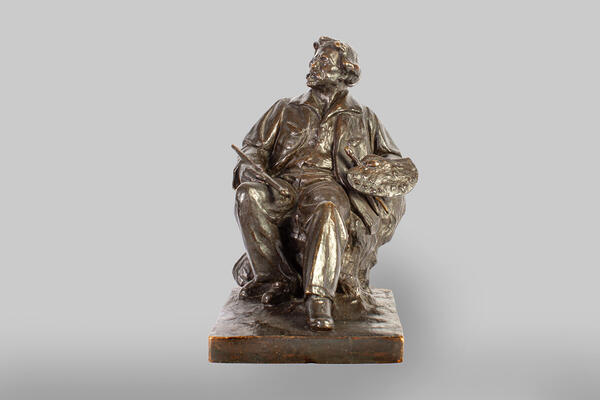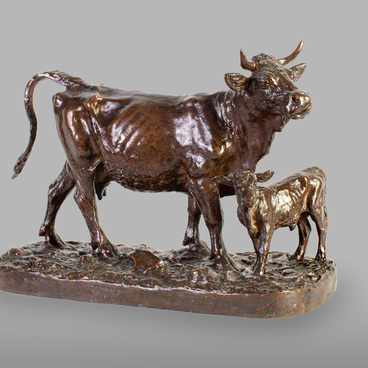The Tambov Art Gallery houses a bronze figurine depicting the great Russian painter Ilya Yefimovich Repin. The work was created by an applied artist and sculptor Yakov Abramovich Troupyansky. Among his other works are a number of vivid images made at the Leningrad State Porcelain Factory, including a sculpture of the singer Feodor Chaliapin and a bust of the writer Fyodor Dostoevsky. One of the interesting and rare sculptures is “Red Army Soldier with a Book”.
Yakov Abramovich Troupyansky was born in Odessa in 1878. Between 1892 and 1898, the future sculptor studied at the Odessa Art School. In 1897, he was an intern at the Naples Academy of Fine Arts. Then he graduated from the Academy of Arts in Saint Petersburg, where he studied under the sculptor Vladimir Beklemishev. Between 1910 and 1919, the early years of his career, Troupyansky was more interested in monumental and decorative sculptures, that decorated the facades and interiors of many buildings in Saint Petersburg and later Leningrad, as well as Kharkiv, Kyiv, and Odessa. From 1921 to 1934, Yakov Troupyansky was the head of a bronze artistic casting workshop in Leningrad. Between 1934 and 1941, the sculptor worked closely with the Navy Construction Administration, for which he made his sculptures. With the beginning of the Great Patriotic War, Troupyansky started to work on the restoration and preservation of monuments in Leningrad. After the war, between 1949 and 1955, he worked as a professor at the Department of Drawing, Painting and Sculpture of the Leningrad Institute of Architecture and Civil Engineering.
The bronze sculpture of Ilya Yefimovich Repin embodies the image of an artist, struck by inspiration. Repin became interested in drawing at an early age: he studied to be a topographer and was an apprentice to icon painters. Repin entered the Academy of Arts only on the second attempt and later returned there to teach. The famous painter received commissions from Saint Petersburg aristocracy and even Emperor Alexander III himself. Leo Tolstoy once said that Repin was able to reflect the national characteristics of Russian life much brighter than other painters. Repin and Tolstoy are two recognizable names in world art. In many ways, they complemented each other. With their spiritual deepness and epic characters, the best works of the artist are quite on par with the books of the great writer, who was an expert of the human soul. Another thing that points to their similarities is the fact that the works of both of them received European-wide recognition.
Yakov Abramovich Troupyansky was born in Odessa in 1878. Between 1892 and 1898, the future sculptor studied at the Odessa Art School. In 1897, he was an intern at the Naples Academy of Fine Arts. Then he graduated from the Academy of Arts in Saint Petersburg, where he studied under the sculptor Vladimir Beklemishev. Between 1910 and 1919, the early years of his career, Troupyansky was more interested in monumental and decorative sculptures, that decorated the facades and interiors of many buildings in Saint Petersburg and later Leningrad, as well as Kharkiv, Kyiv, and Odessa. From 1921 to 1934, Yakov Troupyansky was the head of a bronze artistic casting workshop in Leningrad. Between 1934 and 1941, the sculptor worked closely with the Navy Construction Administration, for which he made his sculptures. With the beginning of the Great Patriotic War, Troupyansky started to work on the restoration and preservation of monuments in Leningrad. After the war, between 1949 and 1955, he worked as a professor at the Department of Drawing, Painting and Sculpture of the Leningrad Institute of Architecture and Civil Engineering.
The bronze sculpture of Ilya Yefimovich Repin embodies the image of an artist, struck by inspiration. Repin became interested in drawing at an early age: he studied to be a topographer and was an apprentice to icon painters. Repin entered the Academy of Arts only on the second attempt and later returned there to teach. The famous painter received commissions from Saint Petersburg aristocracy and even Emperor Alexander III himself. Leo Tolstoy once said that Repin was able to reflect the national characteristics of Russian life much brighter than other painters. Repin and Tolstoy are two recognizable names in world art. In many ways, they complemented each other. With their spiritual deepness and epic characters, the best works of the artist are quite on par with the books of the great writer, who was an expert of the human soul. Another thing that points to their similarities is the fact that the works of both of them received European-wide recognition.






